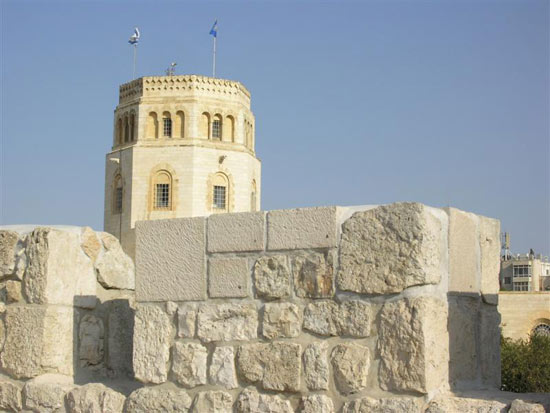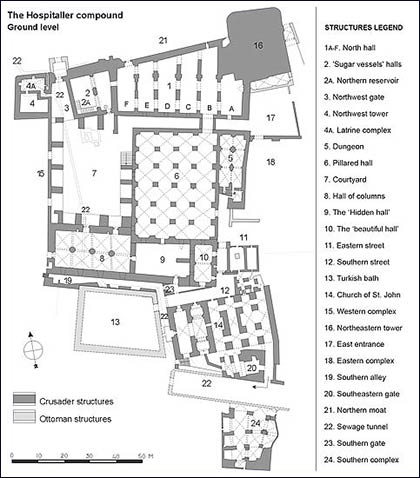In Israel, archeological conservation is part and parcel of archaeological excavations.
The Conservation Department was established in 1988 as the professional arm of the Israel Antiquities Authority specializing in conservation.
The department’s aim is to preserve Israel’s cultural heritage based on the state’s understanding of the country’s multifaceted cultural values. The department is charged with preserving the archaeological and cultural heritage values of all ethnic and religious groups through recognition of the importance and contribution of every culture that lived here to our lives in the present and for the education of generations to come.
Three
projects exemplify the significance of the conservation process to the country’s multi-faceted heritage and religious diversity - Jewish, Moslem and Christian.
The project was initiated in 2007 as a result of stones falling into a school adjacent to the wall.
The Old City walls of Jerusalem are the largest and most impressive monument in the city’s urban landscape and one of its most important cultural heritage assets. They are approximately four kilometers long, with seven portals set in them: the four original main gates that point in the four cardinal directions and three secondary or later gates.
The city walls that we are currently familiar with were erected during the Ottoman period at the initiative of the sultan, Suleiman the Magnificent. These walls are the latest in a series of fortifications that enclosed Jerusalem throughout history. Some of the ancient walls are incorporated in the construction of the Ottoman fortifications and can be seen in certain segments. The Ottoman period city walls are preserved in their entirety, with the exception of a few changes that were done to sections of them.
 Section of the Old City wall after preservation.
Section of the Old City wall after preservation.
Photo courtesy of the IAA Conservation Department.Over time the condition of the city’s walls, which are exposed to constant destructive processes and damage, has deteriorated.
While the project’s main goal is to conserve the walls, the conservationists have come to realize how sensitive anything connected with intervening in this monument can be, and find it necessary to find a balance between the ongoing bustling commercial activity of the surroundings and the conservation of elements representative of the wall’s architectural, urban and historic values while still maintaining the diverse cultural impressions that are apparent in it.
In 2012 a project to document and perform a physical-engineering survey of the mosque compound in the remains of the village of Hittin was initiated. The compound is situated at the foot of the Horns of Hittin ridge, on a moderate slope to the south of the Arbel Valley. The aim of the project was to establish a basis of information that will be of assistance in conserving the structure.
The mosque compound, which dates to the late eighteenth century, comprises several buildings: a mosque composed of two spaces and a minaret, a separate lavatory, a rectangular structure built of cross vaults (now mostly destroyed) and a stone wall surrounding the compound.
The significance of the site is based on its historical, architectural, landscape and social-religious value.
 Remnants of a vaulted building in Hittin. Photo: IAA/Ido Rosenthal
Remnants of a vaulted building in Hittin. Photo: IAA/Ido RosenthalFrom the historical viewpoint, the compound comprises tangible evidence of the Arab village of Hittin, which was demolished in the 1960s. The bullet marks in the building’s walls are part of the history of the place and are a result of the Jewish-Arab conflict. Architecturally, components characteristic of a Muslim religious structure were preserved in the mosque. The mosque compound and nearby outbuildings are remains of a socio-religious compound that was used by the village inhabitants. In recent years the mosque has been used by Muslims who come to pray at the site.
The maintenance work carried out in the compound attests to its emotional, religious and political importance.
A wealth of cultural values – historical/archaeological, landscape, urban, architectural and artistic, as well as social and religious – is present between and around the city walls of Old 'Akko’, which preserves substantial remains of its medieval Crusader buildings beneath the existing fortified Moslem town, which dates from the eighteenth and nineteenth centuries. These values are embodied in both the tangible and intangible heritage assets of the city.
The preparation of a new master plan was completed at the time
UNESCO declared Old 'Akko a World Heritage city (2001), and was approved in 2007. For the first time in Israel, a conservation addendum based on an urban survey of all the buildings located within the city walls was appended to the master plan.
Not only do the Crusader remains provide us with an exceptional picture of the layout and structures of the Crusader city that was the capital of the Crusader Kingdom of Jerusalem in the thirteenth century, but present day Acre is an important example of a walled Ottoman town with very well-preserved, typical urban components such as the citadel, mosques, khans and baths that are partly built on top of the underlying Crusader remains.
 Plan of the Hospitaller compound. Image courtesy IAA/Ra'anan Kislev
Plan of the Hospitaller compound. Image courtesy IAA/Ra'anan KislevAt the beginning of the 1990’s the structural condition of the Hall of Pillars in the Knights Hospitaller compound became unstable and conservation measures were implemented to save the hall and develop the underground complex for tourism. In the resultant extensive archaeological excavation, most of the Knights Hospitaller compound was exposed, as were the streets to the east and south of the compound. An excavation was also carried out in the Church of Saint John, which is located just to the southeast of the compound. The archaeological excavation of the Crusader remains and the exposure of a multi-period complex reveal exactly how the built-up area in the city took shape during its two golden ages – the thirteenth century and the eighteenth-nineteenth centuries.
Additional conservation projects are currently underway around the country, and others are being planned in accordance with a conservation policy that outlines the principals and decision-making methods pertaining to the conservation of heritage sites specified in a scheme of guidelines and standards defining the framework of conservation work subject to the Law of Antiquities.
The current policy was formulated based on the Conservation Charter of 1997 and international accords, among them the Charter of Venice (1964), Charter of Burra (1999) and the Principals for Conserving Heritage Sites in China (2002), as well as based on the accumulated experience and the research that has been conducted by the Conservation Department and the Israel Antiquities Authority.